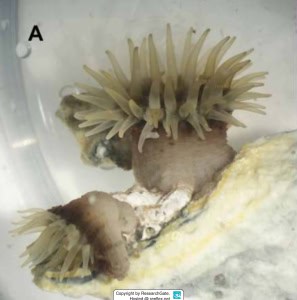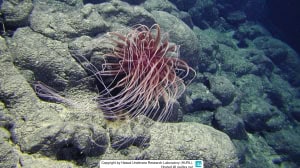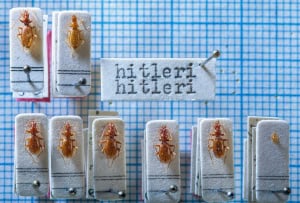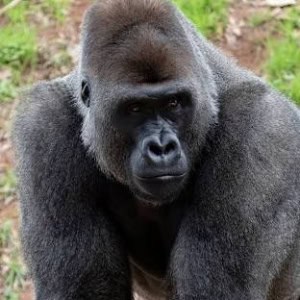Taxonomy: A Path to Immortality
By Joni Johnson
Have you ever had an animal named after you? Right now, I know of only two individuals here at RVM that have met this criterion. (If there are others, please let me know). Bob Buddemeier has been immortalized with Anthopleura buddemeieri It is a small sea anemone called the pink spotted bead anemone.

Anthopleura buddemeieri
His deceased wife (and former RVM resident), Daphne Fautin, has many sea anemones named after her. She has been called the world authority on sea anemones, and has identified at least 19 new species. Boloceroides daphneae was originally named for Daphne because it was thought to be a sea anemone. But recently the name was changed to Relicanthus daphneae as a whole new animal suborder.

Relicanthus Daphne
Bob Buddemeier described the discovery and naming of “his” sea anemone.
“Daphne and I were in Papua New Guinea. She was looking for sea anemones, and we were in a place where earthquakes had moved the coast and islands upwards out of the sea. I was looking for a sample that could be age-dated to find out when these earthquakes had happened. We were at the shoreline, and I was looking at coral heads that had been raised up out of the water, because that was a definite clue that something had taken them out of their environment, pushed them up. And corals are pretty good for carbon dating. So Daphne was squishing around in the water, and I was hitting these uplifted corals with a hammer to try and see what shape they were in, and I saw this little fleshy stuff in some of the pores on the coral. I said, Daphne, I think there’s an anemone here, a little anemone. She looked up and she said, ‘No, that’s too high; that’d be out of the water. They wouldn’t live there.’ I said, well, but there’s something here that looks like it’s alive. So just come and tell me what it is. She came over and said, ‘well, hmm, that that does look sort of like an anemone. Let’s take some home.’
So we did, and it was an anemone. It turns out that it pretty much always lives very high in the intertidal and it only needs to get wet occasionally. It keeps itself wet for a long time, so it doesn’t have to be down in the water where you expect anemones to be. Once people started looking for it, it turned out to be pretty common. It took Daphne a number of years to get around to describing it in the scientific literature.” But eventually, she did and so Anthopleura buddemeieri was named.
I asked Bob how he felt about being the namesake of a new species of anemone and he said “It’s sort of good because probably that’s the thing that will last the longest. People are still using names of things that were named in the 1700s so that will be the last thing that disappears from being associated with my name in terms of whatever I’ve done.”
Some think having an animal named after you is exciting because it signifies a unique and lasting legacy in the natural world, essentially immortalizing your name by associating it with a specific species. It often highlights your contributions to science, conservation or a particular field related to the animal’s habitat. It’s a tangible way to be remembered and connected to the natural environment. Seeing an animal named after someone can inspire others to pursue careers in science.
Taxonomy and the naming of species is pretty standard. The name is italicized when printed, the Genus (the first part of the name) is always capitalized, and the species name (second part) is always lower case and ends in a Greek or Latin word or grammatical form. The ae in daphneae is the Latin feminine possessive and the i at the end of buddemeieri is the masculine possessive. Typically, a new species is not named after the person who described it. Its name may be descriptive, or it may be named after a person who is in some way notable.
For example, Phialella zappai is a species of jellyfish. It was named for musician Frank Zappa[1] by Ferdinando “Nando” Boero, a jellyfish expert from Genoa, Italy who admired Zappa. Boero wrote to

Megapropodiphora arnoldi
Zappa, hoping to meet the musician. Zappa replied saying “there is nothing I would like better than having a jellyfish with my name”, leading to a meeting and eventually a friendship between the two of them. Other animals named after famous persons include Megapropodiphora arnoldi, a seemingly muscled fly which bears more than a little resemblance to Arnold Schwarzenegger, aside from being only 0.395 millimeters long.

Hitler Bug
There is also a sightless beetle found in the damp caves of Slovenia named Anophthalmus hitleri. Appropriately, Anophthalmus hitleri, or “eyeless Hitler,” is a significant predator that Doug Yanega, an entomologist at the University of California, Riverside, said is probably near the top of the micro-animal food chain and “eats anything smaller and weaker than it.” Still, the connection to the despot has been deemed so unsavory that when the creature was featured on a Yugoslavian postage stamp in 1984, its Latin name was withheld. The beetle’s name is causing an uproar in the taxonomy world because of whom its species name stands for, and efforts are being made to change it. The is not simple, because The International Commission on Zoological Nomenclature, which administers the rules for naming animals, is reluctant to authorize changes for reasons other than a change in the scientific status of the critter. (From Press Reader 12/29/2023
Another eye-catching name is Gorilla gorilla gorilla, an endangered Gorilla subspecies (the Western Lowland Gorilla). As scientists are commonly no longer familiar with Greek or Latin, more translation errors are likely to crop up — for example, Scelidosaurus was intended to mean ” Limb Lizard” but it actually translates to “Rib of Beef Lizard”. Another example of a name that I find odd is Brachiosaurus. It translates to “Arm Lizard” which I’m sure many of you can agree is not the most notable feature of the animal.

Gorilla gorilla gorilla
What names do you find interesting? Here is a list of some of the odd ones:
https://listverse.com/2020/09/05/top-10-hilarious-scientific-names/


I am the author of UWASIS II, A Taxonomy of Social Goals and Human Services
[United Way of America Services Identification System, Second Expanded Edition of UWASIS, November 1976. Please contact me at Manor X 6606 if interested